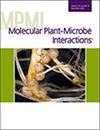Intraspecific Variation and Recent Loss of Ancient, Conserved Effector Genes in the Sudden Oak Death Pathogen Phytophthora ramorum .
IF 3.4
3区 生物学
Q2 BIOCHEMISTRY & MOLECULAR BIOLOGY
Nicholas C Cauldron, Caroline M Press, Alexandra J Weisberg, Marília Horta Jung, Tamara Corcobado, Joan F Webber, Koji Kageyama, Ayaka Hieno, Hayato Masuya, Seiji Uematsu, Bruno Scanu, Clive M Brasier, Thomas Jung, Jeff H Chang, Niklaus J Grünwald
求助PDF
{"title":"Intraspecific Variation and Recent Loss of Ancient, Conserved Effector Genes in the Sudden Oak Death Pathogen <i>Phytophthora ramorum</i>.","authors":"Nicholas C Cauldron, Caroline M Press, Alexandra J Weisberg, Marília Horta Jung, Tamara Corcobado, Joan F Webber, Koji Kageyama, Ayaka Hieno, Hayato Masuya, Seiji Uematsu, Bruno Scanu, Clive M Brasier, Thomas Jung, Jeff H Chang, Niklaus J Grünwald","doi":"10.1094/MPMI-10-24-0131-R","DOIUrl":null,"url":null,"abstract":"<p><p>Members of the <i>Phytophthora</i> genus are responsible for many important diseases in agricultural and natural ecosystems. <i>Phytophthora ramorum</i> causes devastating diseases of oak and tanoak stands in U.S. forests and larch in the United Kingdom. The four evolutionary lineages involved express different virulence phenotypes on plant hosts, and characterization of gene content is foundational to understanding the basis for these differences. Recent discovery of <i>P. ramorum</i> at its candidate center of origin in Asia provides a new opportunity for investigating the evolutionary history of the species. We assembled high-quality genome sequences of six <i>P. ramorum</i> isolates representing three lineages from Asia and three causing epidemics in Western U.S. forests. The six genomes were assembled into 13 putative chromosomes. Analysis of structural variation revealed multiple chromosome fusion and fission events. Analysis of putative virulence genes revealed variations in effector gene composition among the sequenced lineages. We further characterized their evolutionary history and inferred a contraction of crinkler-encoding genes in the subclade of <i>Phytophthora</i> containing <i>P. ramorum</i>. There were losses of multiple families and a near complete loss of paralogs in the largest core crinkler family in the ancestor of <i>P. ramorum</i> and sister species <i>P. lateralis</i>. Secreted glycoside hydrolase enzymes showed a similar degree of variation in abundance among genomes of <i>P. ramorum</i> lineages as that observed among several <i>Phytophthora</i> species. We found plasticity among genomes from multiple lineages in a <i>Phytophthora</i> species and provide insights into the evolutionary history of a class of anciently conserved effector genes. [Formula: see text] Copyright © 2025 The Author(s). This is an open access article distributed under the CC BY 4.0 International license.</p>","PeriodicalId":19009,"journal":{"name":"Molecular Plant-microbe Interactions","volume":" ","pages":"440-453"},"PeriodicalIF":3.4000,"publicationDate":"2025-05-01","publicationTypes":"Journal Article","fieldsOfStudy":null,"isOpenAccess":false,"openAccessPdf":"","citationCount":"0","resultStr":null,"platform":"Semanticscholar","paperid":null,"PeriodicalName":"Molecular Plant-microbe Interactions","FirstCategoryId":"99","ListUrlMain":"https://doi.org/10.1094/MPMI-10-24-0131-R","RegionNum":3,"RegionCategory":"生物学","ArticlePicture":[],"TitleCN":null,"AbstractTextCN":null,"PMCID":null,"EPubDate":"2025/6/3 0:00:00","PubModel":"Epub","JCR":"Q2","JCRName":"BIOCHEMISTRY & MOLECULAR BIOLOGY","Score":null,"Total":0}
引用次数: 0
引用
批量引用
Abstract
Members of the Phytophthora genus are responsible for many important diseases in agricultural and natural ecosystems. Phytophthora ramorum causes devastating diseases of oak and tanoak stands in U.S. forests and larch in the United Kingdom. The four evolutionary lineages involved express different virulence phenotypes on plant hosts, and characterization of gene content is foundational to understanding the basis for these differences. Recent discovery of P. ramorum at its candidate center of origin in Asia provides a new opportunity for investigating the evolutionary history of the species. We assembled high-quality genome sequences of six P. ramorum isolates representing three lineages from Asia and three causing epidemics in Western U.S. forests. The six genomes were assembled into 13 putative chromosomes. Analysis of structural variation revealed multiple chromosome fusion and fission events. Analysis of putative virulence genes revealed variations in effector gene composition among the sequenced lineages. We further characterized their evolutionary history and inferred a contraction of crinkler-encoding genes in the subclade of Phytophthora containing P. ramorum . There were losses of multiple families and a near complete loss of paralogs in the largest core crinkler family in the ancestor of P. ramorum and sister species P. lateralis . Secreted glycoside hydrolase enzymes showed a similar degree of variation in abundance among genomes of P. ramorum lineages as that observed among several Phytophthora species. We found plasticity among genomes from multiple lineages in a Phytophthora species and provide insights into the evolutionary history of a class of anciently conserved effector genes. [Formula: see text] Copyright © 2025 The Author(s). This is an open access article distributed under the CC BY 4.0 International license.
栎树猝死病原菌疫霉的种内变异和古代保守效应基因的新近丢失。
疫霉属的成员是农业和自然生态系统中许多重要疾病的罪魁祸首。疫霉引起了橡树的毁灭性疾病,美国森林中的橡树和英国的落叶松。这四种进化谱系在植物宿主上表达不同的毒力表型,基因含量的表征是理解这些差异的基础。最近在亚洲的候选起源中心发现了拉麻麻,为研究该物种的进化史提供了新的机会。我们收集了来自亚洲的三个谱系和在美国西部森林引起流行的三个谱系的6个拉蒙疟原虫分离株的高质量基因组序列。6个基因组被组装成13条推定的染色体。结构变异分析揭示了多染色体融合和裂变事件。对假定的毒力基因的分析揭示了在测序谱系中效应基因组成的差异。我们进一步表征了它们的进化史,并推断出在含有拉氏疫霉的疫霉亚枝中有一个编码褶皱的基因的收缩。在毛竹和姊妹种侧枝毛竹的祖先中,最大的核心皱纹科有多个科的消失,并且近亲几乎完全消失。分泌的糖苷水解酶在不同系间的基因组丰度差异与在几种疫霉菌种间的差异相似。我们在一个疫霉物种的多个谱系中发现了基因组的可塑性,并为一类古老的保守效应基因的进化史提供了见解。
本文章由计算机程序翻译,如有差异,请以英文原文为准。
来源期刊
期刊介绍:
Molecular Plant-Microbe Interactions® (MPMI) publishes fundamental and advanced applied research on the genetics, genomics, molecular biology, biochemistry, and biophysics of pathological, symbiotic, and associative interactions of microbes, insects, nematodes, or parasitic plants with plants.

 求助内容:
求助内容: 应助结果提醒方式:
应助结果提醒方式:


